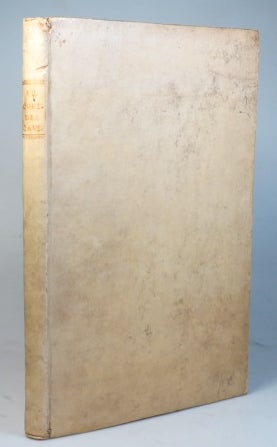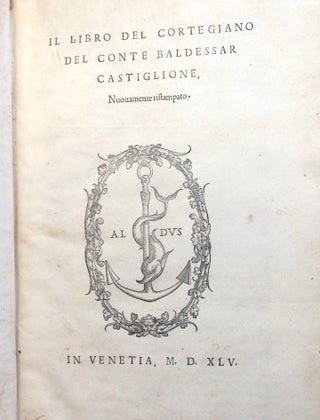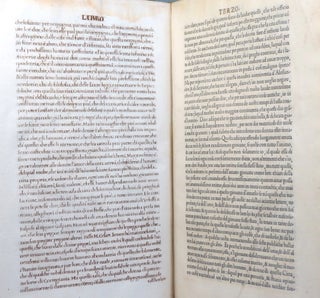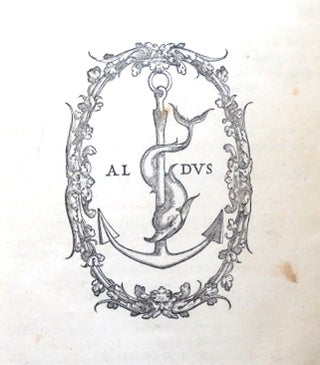Il Libro del Cortegiano del Conte Baldessar Castiglione. Nuouamente Ristampato.
Venetia [Venice]: nelle case de figlioli di Aldo [I Manuzio], 1545. Fourth Aldine printing. Small folio. (122) ff. Eighteenth century full pigskin, gilt lettering to the spine, all edges green, a single leaf in book three lacking but the text supplied in consummate manuscript, predating or contemporary with the binding. Faint dampstain cutting across the upper corner of the last 16 leaves at the gutter, also evident on both pastedowns, a few marks to the boards, an attractive copy. Baldessare Castiglione (1478-1529) was very much a man of his day, educated in a Humanist school in Milan in the 1490s where he also served at the court of Duke Ludovico Sforza. He returned to his native Mantua on the death of his father at the age of 21, whereupon he entered the service of the local marquis, Francesco Gonzaga, for the next five years. During this time he became acquainted with Guidobaldo da Montefeltro, Duke of Urbino, whose court he entered in 1504. Castiglione acted in various capacities for Guidobaldo and his successor, principally diplomatic, though he also played an active role in the flourishing cultural life of the court. His talents took him to Rome in ambassadorial roles for Urbino and subsequently Mantua, leading to his involvement with the Vatican and his later ecclesiastical career (towards the end of his life he was made Bishop of Avila). He is now best remembered for this work, first published in 1528 by the Aldine Press. Written in the form of a dialogue between several protagonists, Castiglione sought to define the courtly ideal. Going beyond a mere book of etiquette, he described the essential characteristics and traits that a courtier should exhibit. These include refinement in the arts, athletic prowess (most obviously in bearing arms), great oratory skills (very much in the Ciceronian tradition) and something which Castiglione termed "sprezzatura". Translated and defined by the Oxford English Dictionary as "studied carelessness", Castiglione suggested that a man about court should eschew flamboyance and grandiosity in favour of a genteel, modest and nonchalant manner and temperament - essentially that all his efforts and undertakings should be worn lightly and completed with as little perceptible exertion as possible. Its contemporary importance is demonstrated by the fact that the Aldine Press had printed it another four times by 1547 (the first four editions in folio as here, the final as an 8vo). By 1616 over 100 further editions, in Italian and in translation, had been published. Unsurprisingly its cultural influence in the succeeding centuries became manifest across Europe with traces of the work found in the writings of Cervantes, Corneille and, amongst others in the English language, Shakespeare, Spenser and Shelley. Printing and the Mind of Man, 59. "It is an epitome of the highest moral and social ideas of the Italian Renaissance..." Item #32371
Price: £4,250.00




